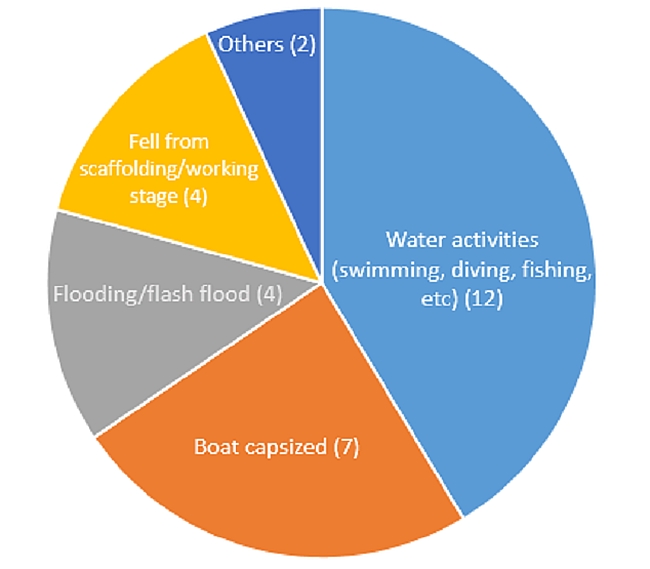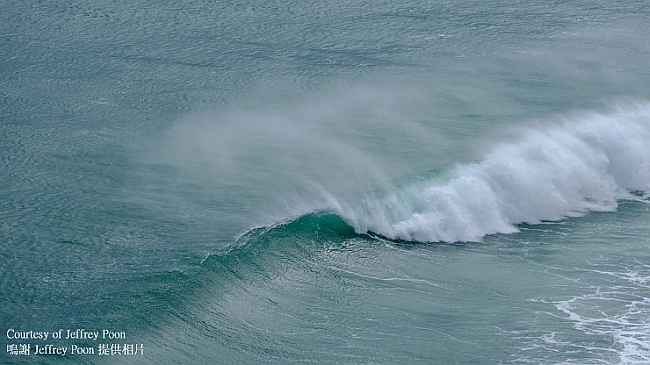The hidden danger of swells, an underestimated killer due to tropical cyclones
8 January 2019
One should still recall the widespread damages in Hong Kong brought by Mangkhut on 16 September 2018. It was fortunate that there was no fatality in Hong Kong on that day. According to the Observatory's records, there was no fatality for the past three "Signal No. 10" storms including Mangkhut. However, a recent unfortunate incident happened on 31 October 2018 when Severe Tropical Storm Yutu was located about 600 km southeast of Hong Kong and the Standby Signal No. 1 was in force. A young man was tragically drowned in the rough seas while surfing in Shek O that afternoon. According to press reports, 29 people were killed or missing when tropical cyclone warning signals were in force since 2000. About 40% of these incidents were associated with water activities. Among them, eight were engaging in swimming, surfing or diving; three were swept away while fishing; another one, an off-duty fireman, tragically lost his life while attempting to save a swimmer in rough seas.
Actually, the threats of tropical cyclone are not limited to the associated inclement weather (e.g. high winds, squally heavy rain, storm surge, etc.) when it comes close. A tropical cyclone can also inflict casualties when it is located at hundreds of kilometres away from us. Huge waves are usually whipped up by high winds associated with tropical cyclones. These waves could travel much further away from the storm and they are known as swells. Affected by the outer subsiding air of a distant tropical cyclone, local weather may be deceptively fine with light winds. In such situations, the awareness of the public on the effect of the weather would usually be lowered. As swells travel at speeds much faster than the movement of tropical cyclone, when the storm is still at a distance, the severe swells generated by it could have already reached Hong Kong. Even worse is that the wave heights would increase suddenly when these swells enter shallow water of the shore and attack the shoreline with a surprise, posing hazards to people close to the shoreline or engaging in water sports activities. Therefore, when tropical cyclone warning is in force, we should be on the alert and pay attention to the announcement and swell information provided by the Hong Kong Observatory. Members of the public should also stay away from the shoreline and avoid engaging in water sports activities.

Figure 1 Cases of death or missing during tropical cyclone passages since 2000

Figure 2 Swells can pose hazards to people close to the shoreline or engaging in water sports activities
HUI Kin-chung and CHEUNG Sze-yuen
References:
B. Y. Lee: Caught red-handed
https://www.weather.gov.hk/blog/en/archives/00000033.htm
CHAN Chik-cheung: Swells from distant typhoons
https://www.weather.gov.hk/education/article_e.htm?title=ele_00171
Hong Kong Observatory video: Tropical cyclone swells
This link will open in a new windowhttps://youtu.be/8NJUHduPnhE





 Local Weather
Local Weather Weather Forecast
Weather Forecast Weather Warnings
Weather Warnings Weather for Fishermen
Weather for Fishermen Weather for Marine
Weather for Marine Weather for Aviation
Weather for Aviation Weather Monitoring Imagery
Weather Monitoring Imagery GIS Weather Service
GIS Weather Service Tropical Cyclone
Tropical Cyclone China Weather
China Weather World Weather
World Weather Climate Information Service
Climate Information Service Warnings & Signals Database
Warnings & Signals Database Statistics of Special Weather Events
Statistics of Special Weather Events Monthly Weather Summary
Monthly Weather Summary Climate Change
Climate Change El Nino and La Nina
El Nino and La Nina Earthquakes
Earthquakes Tsunamis
Tsunamis Tide
Tide Geomagnetism
Geomagnetism Space Weather
Space Weather Weather Information for Astronomical Observation
Weather Information for Astronomical Observation Interactive Sun Path Diagram
Interactive Sun Path Diagram Astronomical Data
Astronomical Data Interesting Astronomical Phenomena
Interesting Astronomical Phenomena Time Services
Time Services Calendar
Calendar Almanac
Almanac Real time Radiation level in Hong Kong
Real time Radiation level in Hong Kong Understanding Radiation
Understanding Radiation Radiation Monitoring, Assessment and Protection
Radiation Monitoring, Assessment and Protection Environmental Radiation Monitoring Programme
Environmental Radiation Monitoring Programme Daya Bay Contingency Plan
Daya Bay Contingency Plan Related Sites
Related Sites Schools
Schools Travel
Travel Sports
Sports Outdoor Photography
Outdoor Photography CWOS
CWOS Senior Citizens
Senior Citizens Stargazers
Stargazers FoOb
FoOb My Little Observatory
My Little Observatory Educational Resources
Educational Resources 360 Tour of HKO
360 Tour of HKO Cloud Appreciation by Dr Tin
Cloud Appreciation by Dr Tin International Cloud Atlas
International Cloud Atlas Guided Tour
Guided Tour Courses and Activities for the Public
Courses and Activities for the Public Subscription of e-Bulletins
Subscription of e-Bulletins Research Forum
Research Forum Publications
Publications International Atomic Energy Agency
International Atomic Energy Agency Regional Specialized Meteorological Centre for nowcasting
Regional Specialized Meteorological Centre for nowcasting Asian Aviation Meteorological Center
Asian Aviation Meteorological Center Social Media
Social Media Press Releases
Press Releases What's New
What's New HKO Updates
HKO Updates LegCo Questions and Answers
LegCo Questions and Answers Observatory's Blog
Observatory's Blog Weather On-Air
Weather On-Air Cool Met Stuff
Cool Met Stuff Central Briefing
Central Briefing Tropical Cyclone Report Broadcast
Tropical Cyclone Report Broadcast Observatory's News
Observatory's News Vacancies
Vacancies Tender Notices
Tender Notices Apps
Apps Personalized Website
Personalized Website Weather Wizard
Weather Wizard Weather Information in Text
Weather Information in Text Weather Information in RSS
Weather Information in RSS Audio Web Page
Audio Web Page Forms
Forms Open Data
Open Data HKO Corporate Video
HKO Corporate Video Vision and Mission
Vision and Mission Organizational Structure
Organizational Structure Quality Management
Quality Management Hong Kong Observatory – The Facts
Hong Kong Observatory – The Facts Hong Kong Observatory 2024
Hong Kong Observatory 2024 Our Services
Our Services Programme Areas of the Observatory
Programme Areas of the Observatory History of the Hong Kong Observatory
History of the Hong Kong Observatory Career@HKO
Career@HKO Visitors Figures
Visitors Figures











